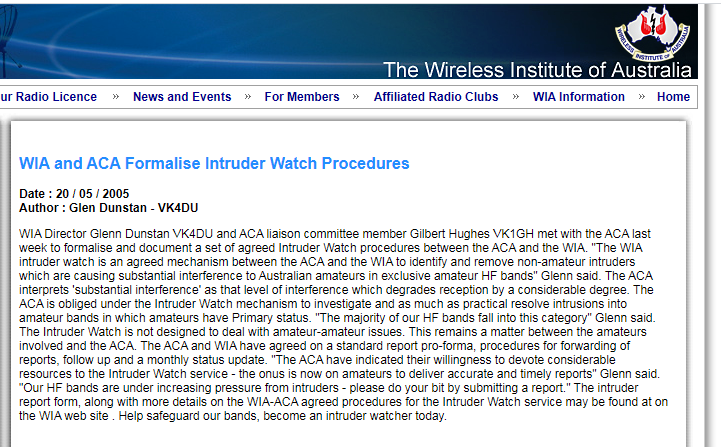By Glenn VK4DU
“Insanity is doing the same thing over and over again and expecting different results.”
(anon – often attributed incorrectly to Einstein..)
On the WIA news of 25 Oct 2020,
(https://www.wia.org.au/members/broadcast/wianews/display.php?file_id=wianews-2020-10-25)
the Vice President urges us to submit reports to the IARU Intruder Watch (IW) system, as, apparently, this will “not waste precious volunteer time, and actually provide proper reporting to the appropriate authorities to address the intruders and their removal from the Amateur bands (sic)”.
Many of the words in the news report above regarding the monitoring service were actually written by yours truly in 2005. I ran the IARU IW service in VK when I was a WIA Director. Indeed, I developed the forms and negotiated the agreement with the regulator as described.
A screenshot of the news item from 2005 is enclosed below.
Many of you would have read of our recent experiences with the IARU IW system in this piece published a few days ago. For more history on these matters, search “QRM 40m” on our website.
Is the IARU IW system effective? Should VK amateurs continue to send in reports, in some vain hope that things will change, and intruders magically disappear?
Neither the IARU Region 3 nor the WIA have provided any status reports or evidence of real progress on these matters for many years.
Here at RASA, we believe in a more honest and pragmatic approach to communication and representation. We provide clear, objective information, so that amateurs may make an informed decision. We challenge systems where we see a lack of effectiveness.
The IW system collates reports from amateurs and passes them to the national regulator – in our case, ACMA. The regulator prioritises the reports and conducts their own monitoring (and DF’ing), in accordance with ITU guidelines.
If the monitoring proves that the interference is genuine and “harmful”[1], a formal report is forwarded to the ITU Radiocommunications Bureau, who then pass the report to the other Administration (country) concerned.
The ITU International Monitoring System is defined in Article 16 of the Radio Regulations. It is quite formalised – for instance, all administrations participating use calibrated antennas of a standard design. There are specific rules for monitoring and declaring interference “harmful”. It isn’t a matter of just listening for a short while – a program of monitoring is required, over a period of time.
As discussed in our IARU piece, the most chronic QRM emanates from Indonesia on 40m. There have been literally thousands of monitoring reports submitted on this problem – I collated many of them in my time as the VK IW coordinator over 15 years ago.
Thousands of reports…over more than 15 years…and the QRM is still there….louder than ever…
RASA conducted our own IW project in 2018. We submitted detailed reports on the 40m QRM to ACMA and requested they conduct formal monitoring with a view to a report through the ITU system.
ACMA advised at the time that, due to pressure of other work, they were unable to conduct the required monitoring.
So, at the moment, it appears that there is no point in VK amateurs submitting IW reports, as there is no mechanism for them to be processed, actioned and fed into the official ITU system.
However, given that the 40m QRM is as bad as ever, and is clearly “harmful”, we have written to ACMA again, asking that they conduct official monitoring and report to ITU.
ACMA advised on the 11th March 2021 that they will not take any further action on this issue….
So, if the regulator will not act on such longstanding QRM, that is clearly “harmful” to an amateur primary allocation, there is no point submitting reports to the IW system regarding QRM from overseas stations.
73
[1] Harmful interference is defined as interference that:
- endangers the functioning of a radionavigation service or other safety services that are operating in accordance with the Radio Regulations; or
- obstructs, repeatedly interrupts or seriously degrades a communications service operating in accordance with the Radio Regulations.”
